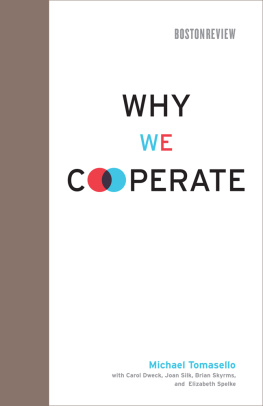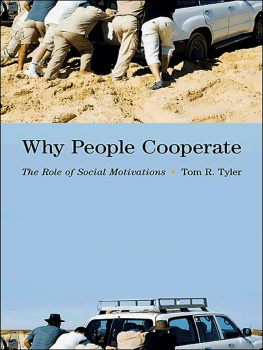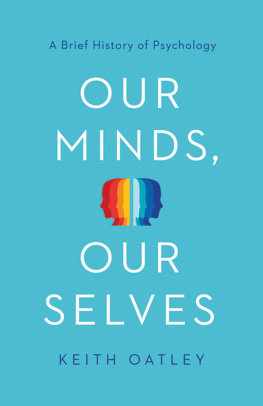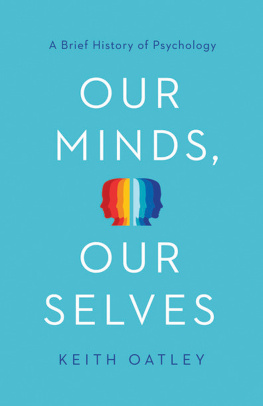Michael Tomasello - Why We Cooperate
Here you can read online Michael Tomasello - Why We Cooperate full text of the book (entire story) in english for free. Download pdf and epub, get meaning, cover and reviews about this ebook. year: 2009, publisher: MIT Press, genre: Children. Description of the work, (preface) as well as reviews are available. Best literature library LitArk.com created for fans of good reading and offers a wide selection of genres:
Romance novel
Science fiction
Adventure
Detective
Science
History
Home and family
Prose
Art
Politics
Computer
Non-fiction
Religion
Business
Children
Humor
Choose a favorite category and find really read worthwhile books. Enjoy immersion in the world of imagination, feel the emotions of the characters or learn something new for yourself, make an fascinating discovery.
- Book:Why We Cooperate
- Author:
- Publisher:MIT Press
- Genre:
- Year:2009
- Rating:4 / 5
- Favourites:Add to favourites
- Your mark:
- 80
- 1
- 2
- 3
- 4
- 5
Why We Cooperate: summary, description and annotation
We offer to read an annotation, description, summary or preface (depends on what the author of the book "Why We Cooperate" wrote himself). If you haven't found the necessary information about the book — write in the comments, we will try to find it.
Why We Cooperate — read online for free the complete book (whole text) full work
Below is the text of the book, divided by pages. System saving the place of the last page read, allows you to conveniently read the book "Why We Cooperate" online for free, without having to search again every time where you left off. Put a bookmark, and you can go to the page where you finished reading at any time.
Font size:
Interval:
Bookmark:
Why We Cooperate
Why We Cooperate
Michael Tomasello
Based on the 2008 Tanner Lectures on Human Values at Stanford
A Boston Review Book
The MIT Press
Cambridge, Massachusetts
London, England
2009 Massachusetts Institute of Technology
All rights reserved. No part of this book may be reproduced in any form by any electronic or mechanical means (including photocopying, recording, or information storage and retrieval) without permission in writing from the publisher.
MIT Press books may be purchased at special quantity discounts for business or sales promotional use. For information, please e-mail or write to Special Sales Department, The MIT Press, 55 Hayward Street, Cambridge, MA 02142.
This book was set in Adobe Garamond by Boston Review and was printed and bound in the United States of America.
Library of Congress Cataloging-in-Publication Data
Tomasello, Michael.
Why we cooperate : based on the 2008 Tanner lectures on human values at Stanford University / Michael Tomasello.
p. cm.
Includes bibliographical references.
ISBN 978-0-262-01359-8 (hardcover : alk. paper)
ISBN 978-0-262-25849-4 (retail e-book)
1. Helping behavior. 2. Altruism. 3. Cooperativeness. 4. Social norms. I. Title.
HM1146.T66 2009
158'.3dc22
2009019631
10 9 8 7 6 5 4 3 2 1
d_r0
yours
Introduction
Individuals of many animal species exploit the experience and hard work of others by learning things from them socially. When individuals socially learn to the degree that different populations of a species develop different ways of doing things, biologists now speak of culture. In this very broad perspective, many animal species live in culturally distinct groups, including a variety of species of birds, marine mammals, and primates.
Humans, of course, are the paradigmatic cultural species. Unlike their nearest great-ape relatives, who all live in Africa or Asia in the general vicinity of the equator, humans have spread out all over the globe. Everywhere they go, they invent new artifacts and behavioral practices for dealing with the exigencies of the local environment. In the Arctic, indigenous populations build igloos and hunt whales in kayaks, whereas in the Tropics they build straw huts and hunt terrestrial mammals with bows and arrows. For humans such artifacts and behavioral practices are not niceties but necessities. Few humans could survive in either the tundra or a tropical rainforest in the absence of a cultural group possessed of relevant, preexisting artifacts and behavioral practices. In terms of the number of things an individual human must socially learn (including linguistic conventions in order to communicate), human culture, as compared with that of other animal species, is quantitatively unique.
But there are two clearly observable characteristics of human culture that mark it as qualitatively unique as well. The first is what has been called cumulative cultural evolution. Human artifacts and behavioral practices often become more complex over time (they have a history). An individual invents an artifact or way of doing things that is adequate to the task, and others quickly learn it. But then if another individual makes some improvement, everyone, including developing children, tends to learn the new and improved version. This produces a kind of cultural ratchet, as each version of the practice stays solidly in the group's repertoire until someone comes up with something even newer and more improved. To date, no animal species other than humans has been observed to have cultural behaviors that accumulate modifications and so ratchet up in complexity over time.
The second clearly observable feature of human culture that marks it as unique is the creation of social institutions. Social institutions are sets of behavioral practices governed by various kinds of mutually recognized norms and rules. For example, all human cultures engage in mating and marriage in the context of their own rules. If one violates these rules, one is sanctioned in some way, perhaps even ostracized totally. As a part of the process, humans actually create new culturally defined entities, for example, husbands and wives (and parents), who have culturally defined rights and obligations (the philosopher John Searle refers to this process as the creation of new status functions). As a different example, all human cultures have rules and norms for sharing or possibly trading food and other valuable objects. In the process of exchange, some objects may be accorded the cultural status of money (e.g., specially marked paper), which gives them a certain, culturally backed role. Other sets of rules and norms create leaders of the group, such as chiefs and presidents, who have special rights and obligations to make decisions, or even create new rules, for the group. As for the cultural ratchet, so for social institutions: no animal species other than humans has been observed to have anything even vaguely resembling the latter.
Underlying these two singular characteristics of human culturecumulative artifacts and social institutionsare a set of species-unique skills and motivations for cooperation. This seems especially obvious in the case of social institutions. Social institutions represent cooperatively organized and agreed-upon ways of interacting, including rules of enforcement for noncooperators. Status functions represent cooperative agreements that such entities as husbands, parents, money, and chiefs exist, and have the rights and obligations that they do. Drawing on the work of philosophers of action such as Michael Bratman, Margaret Gilbert, Searle, and Raimo Tuomela,
Although less obvious, humans' ultra-cooperative tendencies also play a crucial role in the cultural ratchet. It is true that the most basic process involved is imitative learning (which humans seem to employ with great fidelity of transmission), and imitative learning is not inherently cooperative but rather exploitive. But, in addition, two fundamentally cooperative processes are critical for the human cultural ratchet as well.
First, humans actively teach one another things, and they do not reserve their lessons for kin. Teaching is a form of altruism, founded on a motive to help, in which individuals donate information to others for their use. Although a few nonhuman species engage in something like teaching (mostly for single behaviors and with offspring), there are no systematic, replicated reports of active instruction in nonhuman primates.
Second, humans also have a tendency to imitate others in the group simply in order to be like them, that is, to conform (perhaps as an indicator of group identity). Moreover, they sometimes even invoke cooperatively agreed-upon social norms of conformity on others in the group, and their appeals to conformity are backed by various potential punishments or sanctions for those who resist. To our knowledge, no other primates collectively create and enforce group norms of conformity. Both teaching and norms of conformity contribute to cumulative culture by conserving innovations in the group until some further innovation comes along.
And so, whereas the cultures of other animal species are based almost exclusively on imitation and other exploitive processes, the cultures of human beings are based not only on exploitation, but on fundamentally cooperative processes as well. To an unprecedented degree, homo sapiens are adapted for acting and thinking cooperatively in cultural groups, and indeed all of humans' most impressive cognitive achievementsfrom complex technologies to linguistic and mathematical symbols to intricate social institutionsare the products not of individuals acting alone, but of individuals interacting. These special skills arose from processes of cultural niche construction and gene-culture coevolution; that is to say, they arose as adaptations that enabled humans to function effectively in any one of their many different self-built cultural worlds.
Next pageFont size:
Interval:
Bookmark:
Similar books «Why We Cooperate»
Look at similar books to Why We Cooperate. We have selected literature similar in name and meaning in the hope of providing readers with more options to find new, interesting, not yet read works.
Discussion, reviews of the book Why We Cooperate and just readers' own opinions. Leave your comments, write what you think about the work, its meaning or the main characters. Specify what exactly you liked and what you didn't like, and why you think so.








